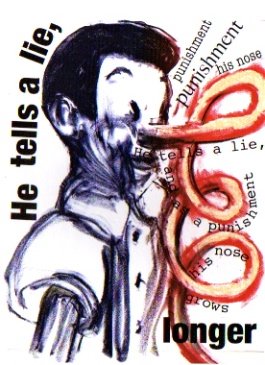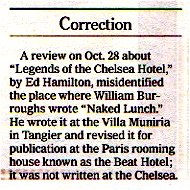Straight Up |: November 2007 Archives
She's making me blush. I don't usually get admiring emails from law profs.
Hi Jan -- I just wanted to introduce myself, having followed your blog with great interest. My name is Sonia Katyal, and I am a law professor who specializes in the area of art, law and technology at Fordham Law School in NYC.
Being a fan of your work, I wanted to send you an abstract and article I finished on intellectual property, appropriation art, copyright, and the notion of the relationship between semiotic democracy and disobedience; it seemed like something that was relevant to your work. I'm thinking of turning part of it into a book, and so would be thrilled for any thoughts you might be able to share -- you can also download the paper for free on SSRN. Feel free to pass it on to interested folks via blog or otherwise, and I'd be grateful for any thoughts you might be able to pass along.
I told her I read the abstract. Twice. I also said I'd have to study it, let alone the paper it refers to, before I had any thoughts she might find worthwhile. Since I'm no academic, the terminology went right by me. Off the top of my head, though, I said the whole issue of postmodern appropriation and what it entails made me gravely ill. I called my illness "conflicted feelings." And just to show I was still breathing, I added, "Whether it's semiotic disobedience or outright theft seems to me to depend on whose ox is gored."
When I was finally able to download the paper itself -- not easy to do, it turned out -- I got a short way in and came across this passage:
...the spirit of semiotic disobedience reflects some of the same classic goals and interests of traditional civil disobedience. The individuals I am speaking of do not expressly seek to reclaim the protection of the law; rather, their very objective is to demonstrate the expressive value of transgressing its limits. If our First Amendment jurisprudence has taught us anything, it has taught us the importance of recognizing the value of symbolic dissent, even when unpopular, as a key mediating tool in integrating the marketplaces of prohibited and protected expression.
Which clarifies what she's getting at. I think. More thoughts, anybody?
I have no idea how many readers wrote to tell them. But I know of at least one. This was my email message to The New York Times Book Review:
One Legend Too ManyTo the editor:
The Chelsea Hotel has so many legends attached to it one less won't hurt. The Chelsea is not "[w]here William Burroughs wrote 'Naked Lunch,'" as Jeff Giles puts it in his review of "Legends of the Chelsea Hotel." ("Chelsea Mornings," Oct. 28) Mr. Burroughs wrote the manuscript at the Villa Muniria in Tangier (at 1 Calle Magallanes, where Jack Kerouac typed up an early version for him) and at the Beat Hotel in Paris (at 9 rue Git-le-Coeur, where Brion Gysin and others helped him prepare a later version for publication).
I sent the email three Sundays ago, on the morning of the review. A few days later I received this automated reply: "Thank you for writing to the editors of the Book Review. We read every e-mail we receive, but cannot always respond. We will contact you if we decide to publish your letter." Never heard from them again.
This morning they ran their correction, unattributed. If they had contacted me, I would have told them my correction was incomplete. And now so is theirs. A key section of "Naked Lunch" was written in a hotel in Copenhagen, as a friend reminded me, and as Ted Morgan writes in his peerless Burroughs biography, "Literary Outlaw":
Burroughs left for Copenhagen in July 1957 ... on an intuition that it would be important for his book. He had four main zones, or sets, where the book takes place -- the United States, South America, Interzone (which was Tangier), and Freeland -- and in Scandinavia he found the real model for his imagined Freeland, a place of the living dead. He had already described it as a series of bars along a canal, which was what he found in Copenhagen. What he saw exceeded the most ghastly product of his imagination. ... The dead-level sanity and bone dullness of the Danes appalled him. It was a police state without police, populated by robots completely conditioned by the state. The only antisocial element was the juvenile delinquents, known locally as "Leather Jackets." It was all horribly depressing, the sandwich bars, the workmen in overalls listening to classical music on the radio, the lack of conversation, the general inanity and squareness of the people.
... Scandinavia catalyzed the novel, which was now taking shape faster than he could write it down in his hotel room. Every time he reached an impasse, something happened to show him the way, so he stayed in Copenhagen through August and worked. The main theme, it was now clear to him, was the desecration of the human image by control addicts. As Lola La Chata, the Mexico City pusher, used to say, "Pushing is more of a habit than using."
You think if I send this item to the Book Review -- naturally with all due apologies to past, present and future generations of the Danish pipples -- that the editors will run a correction to the correction?
Oh yeah.
It is a delicious irony of life in New York to ride the subway during the morning rush hour with Dave Frishberg's "Quality Time" playing on your iPod (listen here). Another irony, not so delish, is to miss what's in front of your eyes. Like walking past the art gallery in the CUNY Graduate Center on Fifth Avenue without seeing the show.
Talk about quality time, "Jim Dine Selected Prints, 1996-2006" gives you as much as you please. It's in the heart of Manhattan (between 34th and 35th Streets) and a helluva lot less crowded than the subway. Cheaper, too. Admission is free. Oh, did I say Dine's prints are a wow?
 Among other things, they offer an eyeful on the not small matter of prevarication, which some would submit is the issue of our time. Have a look at the portraits of Gepetto's boy. There are a handful, and they come in all sizes.
Among other things, they offer an eyeful on the not small matter of prevarication, which some would submit is the issue of our time. Have a look at the portraits of Gepetto's boy. There are a handful, and they come in all sizes.
Pinocchio may not resemble the current occupant of the White House. His nose is longer, for one thing. He's also made of wood, although that's a debatable difference, and he pays for his lies. Most of all, Dine personally identifies with Pinocchio. I doubt he feels that way about our prevaricating prez.
In any case, precisely why crowds are not packing the gallery is a mystery to me. Maybe it's because the art critics have overlooked it. There hasn't been a single review of the show, despite the fact that Dine is an acknowledged master. Some of the prints have been exhibited elsewhere -- in Minneapolis, for instance -- and you know how New York critics hate to be second in line.
Or maybe it's because Dine's work sells, thank you very much, but usually not at auction, and so doesn't go public with humongous prices. Indeed, maybe that's the most important reason.
Dine is among the most commercially successful artists in the Pace Wildenstein stable -- which is saying a lot, given the stable. But without humongous prices to attach to his name, Dine is old news, or worse, no news. No matter how much they may deny it, the critics are artworld functionaries. Money impresses them maybe more than art.
Yes, this is a rant.
Sites to See
AJ Blogs
AJBlogCentral | rssculture
Terry Teachout on the arts in New York City
Andrew Taylor on the business of arts & culture
rock culture approximately
Rebuilding Gulf Culture after Katrina
Douglas McLennan's blog
Art from the American Outback
John Rockwell on the arts
Jan Herman - arts, media & culture with 'tude
dance
Apollinaire Scherr talks about dance
Tobi Tobias on dance et al...
media
Jeff Weinstein's Cultural Mixology
Martha Bayles on Film...
music
Greg Sandow performs a book-in-progress
Howard Mandel's freelance Urban Improvisation
Focus on New Orleans. Jazz and Other Sounds
Exploring Orchestras w/ Henry Fogel
Kyle Gann on music after the fact
Doug Ramsey on Jazz and other matters...
Greg Sandow on the future of Classical Music
Norman Lebrecht on Shifting Sound Worlds
publishing
Jerome Weeks on Books
Scott McLemee on books, ideas & trash-culture ephemera
theatre
Elizabeth Zimmer on time-based art forms
visual
Public Art, Public Space
John Perreault's art diary
Lee Rosenbaum's Cultural Commentary
Tyler Green's modern & contemporary art blog


